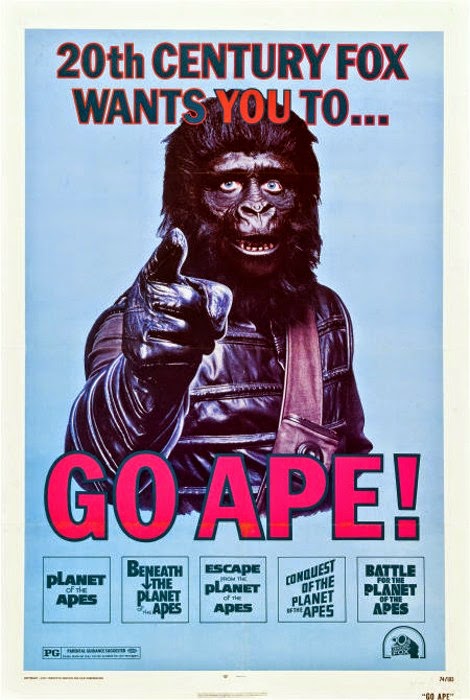Sherman? Set The Way-Back Machine for the summer of 1978. The Rivoli Theater. (Or maybe it was The Strand? It doesn't really matter...) Somewhere, as you enter that darkened theater is a seven year old, who had kinda retreated into his own head after his father suddenly died the year prior and his family broke upon the rock of the headstone. He had yet to see Star Wars (1977), which would also blow his mind. But that was still a couple of months away. And so, then ... Well, now, then, he was kinda lost.
He was there with some school friends for a screening of some old flick about ancient history and monsters; a re-release, and the bombastic commercials for which seen on the old family wood-grained Zenith looked cool as hell. Here, then, now, he sits and watches. A little trepidatious, perhaps, as Bernard Hermann's opening score pounds him into his seat, and some poor maiden is stabbed to death by the bad guy. (This kind of own-mortality reminder plague him constantly, and keeps him awake most nights.) There's a lot of mayhem, and some Greek gods bickering and playing an ersatz game of Risk, screwing with our hero. Intriguing yes, but where were those monsters?
And then it happens. Talos, the iron giant, who moves with the spine-tweaking sound of rending metal; winged harpies, ripping the clothes off some beggar; a giant mer-man, his tail impatiently slapping at the water as he holds back an avalanche of rocks, allowing the mighty Argo to sail under his armpit. (A joke about underarm stink zings through one ear and out the other. He is smiling, but not because of the joke.)
The fight with the Hydra ends too quickly, he thinks, but that was just the pregame warm-up for what happens next: when the Children of the Hydra, an army of skeletons, spring forth from the earth and attack.
And as the movie ended shortly after the battle is won (by default), he doesn't really remember edging to the front of his seat, wanting a closer look at what was happening onscreen. He was well aware of what stop-motion animation was, but he had yet to see it in action like this. (Rankin and Bass Christmas specials and Land of the Lost be damned.) He was boggled. He was mesmerized. And he hadn't thought about death for nearly an hour. The film had drawn him out, and he was hooked.
Over three decades have passed since that first encounter with Jason and the Argonauts (1963) and the magic of Ray Harryhausen. And though I heartily agree that this was Harryhausen's best film, my favorite will always and forever be The Valley of Gwangi -- I'm telling ya, that dino-rodeo is just as impressive, if not more so, than the climactic skeleton fight found here.
Older me can grump that Nigel Green's Hercules left the film too early and Nancy Kovack's Madea arrived too late (and too stripped of her sorcery, while we're at it), and actually, as a matter of fact, I already did for those looking for a more in depth look at the film, but I'm still mesmerized with each viewing, joining the echoes of untold thousands of equally enchanted Harryhausen fans, wondering, just, How in the hell does he do that?
Other Points of Interest:
XX
XXXXXXXXXXXXXXXxxxxxxxxxXXXXXXX-- Danny Peary
"For those of us who thrill to fantasy-adventure films in the Thief of Baghdad (1940) tradition, there is no greater treat than the not-frequent-enough release of a new spectacle featuring the special effects of Ray Harryhausen. It is Harryhausen -- not the actors, not the director -- who is the "star" of the pictures with which he is involved: he is the attraction."
XXXXXXXXXXXXXXXxxxxxxxxxXXXXXXX-- Danny Peary
XX
* * * * * * * * * * * * * * * * * * * * * * * * * * * * * * * * * * * * * * * * * * * *
The Fine Print: Jason and the Argonauts was watched via Sony Pictures Home Entertainment DVD. Watched as a sci-fi/fantasy double-feature with Forbidden Planet (1956). What's the Cult Movie Project? That's eleven down, with 189 to go.
Jason and the Argonauts (1963) Columbia Pictures Corporation / P: Charles H. Schneer / AP: Ray Harryhausen / D: Don Chaffey / W: Jan Read, Beverley Cross, Apollonios Rhodios (poem) / C: Wilkie Cooper / E: Maurice Rootes / M: Bernard Herrmann / S: Todd Armstrong, Nancy Kovack, Gary Raymond, Laurence Naismith, Douglas Wilmer, Nigel Green, Niall MacGinnis, Honor Blackman








































































































%2B1966.jpg)
















%2B1974.jpg)


%2B1971.jpg)
%2B1971_3.jpg)

%2B1971.jpg)

























































